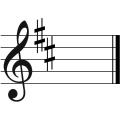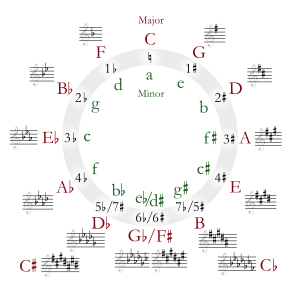B minor facts for kids
 |
||
| Relative key | D major | |
|---|---|---|
| Parallel key | B major | |
| Notes in this scale | ||
| B, C♯, D, E, F♯, G, A, B | ||
B minor is a minor scale that starts on the note B. A musical scale is a set of notes played in a certain order. The B minor scale has a special sound.
In music, a key signature tells you which notes are sharp or flat. The key of B minor has two sharps. This means that F and C notes are played a little higher.
Every minor key has a relative major key. B minor's relative major is D major. It also has a parallel major key, which is B major.
Contents
What B Minor Means in Music History
For a long time, people thought that B minor had a special feeling. In the 1700s, during the Baroque period, some musicians felt it was a key of quiet sadness. Christian Friedrich Daniel Schubart, a German composer, said it sounded like a gentle complaint. This idea fit how composers like Johann Sebastian Bach used it. For example, Bach used B minor in his St. John Passion to show deep emotion.
Later, around the time of Ludwig van Beethoven, feelings about B minor changed. Some thought it was not suitable for elegant music. Beethoven even called a B minor tune in his notes a "black key." This shows it was seen as a serious or dark key.
B Minor in Popular Songs
B minor is not just for classical music. It is used in many popular songs too. A famous example is the first chord of "Comfortably Numb." This hit song by Pink Floyd came out in 1979.
The second movement of Rodrigo's Concierto de Aranjuez is also in B minor. This is a very famous piece for the classical guitar.
Why Guitarists Like B Minor
B minor is a common key in rock, folk, and country music. This is because of how guitars are tuned. The open strings on a guitar (E, A, D, G, B, E) are all notes that fit well into the B minor scale. This makes it easier for guitarists to play in this key.
Famous Classical Pieces in B Minor
Many famous classical composers have written music in B minor. These pieces show the different feelings this key can create.
- Violin Concerto No. 3 (Saint-Saëns) by Camille Saint-Saëns
- Mass in B Minor by Johann Sebastian Bach
- Piano Sonata in B minor by Franz Liszt
- Piano Sonata No. 3 in B Minor, Op. 58 by Frédéric Chopin
- Waltz Opus 69 No. 2 in B Minor by Frédéric Chopin
- Violin Concerto No. 2 in B Minor (La Campanella) by Niccolò Paganini
- Symphony No. 8 in B minor by Franz Schubert
- Symphony No. 6 in B Minor, Op. 74 (Pathetique) by Pyotr Ilyich Tchaikovsky
- E lucevan le stelle from Tosca by Giacomo Puccini
- Cello Concerto in B minor by Antonín Dvořák
- Concerto for 4 Violins and Cello, RV 580 (Concerto No. 10 from L'estro Armonico) by Antonio Vivaldi
| Diatonic Scales and Keys | |||||||||||||||||||||||||||||||||||||||||||||||||||||||
|---|---|---|---|---|---|---|---|---|---|---|---|---|---|---|---|---|---|---|---|---|---|---|---|---|---|---|---|---|---|---|---|---|---|---|---|---|---|---|---|---|---|---|---|---|---|---|---|---|---|---|---|---|---|---|---|
|
|||||||||||||||||||||||||||||||||||||||||||||||||||||||
| The table shows the number of sharps or flats in each scale. Minor scales are written in lower case. | |||||||||||||||||||||||||||||||||||||||||||||||||||||||
See also
 In Spanish: Si menor para niños
In Spanish: Si menor para niños


